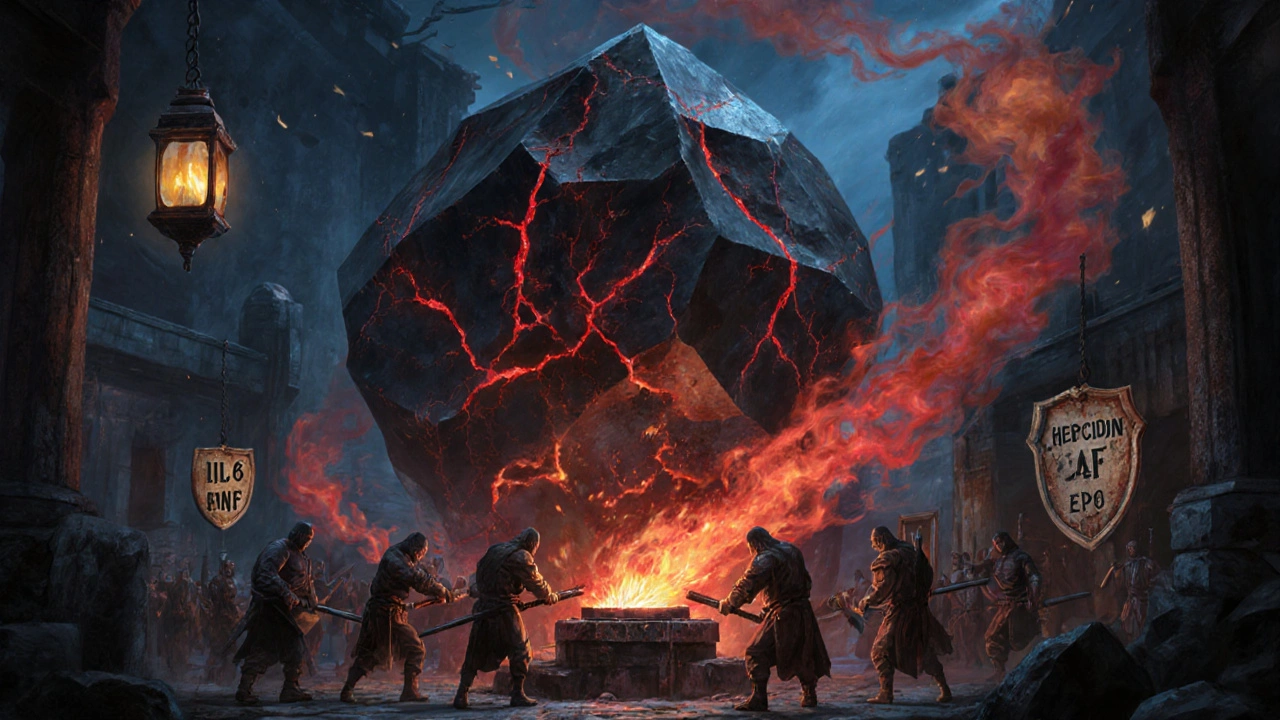
Hepcidin-Iron Availability Calculator
How Hepcidin Affects Iron Availability
This calculator demonstrates how elevated hepcidin levels (common in cancer) block iron absorption. Based on the 2023 colorectal cancer trial showing hepcidin levels 3x higher than controls.
Iron Availability
Enter hepcidin level to see results
Why this matters: When hepcidin exceeds 50 ng/mL, iron is trapped in storage cells. Oral iron supplements won't work - intravenous iron is needed to bypass this blockage (per International Association of Haematology guidelines).
When a cancer patient starts feeling unusually tired, short of breath, or dizzy, the culprit is often anemia. But why does a growing tumor steal the blood’s ability to carry oxygen? Below we untangle the biology, point out the warning signs, and lay out practical steps doctors use to keep the blood healthy while fighting cancer.
What is anemia and why it matters in cancer
Anemia is a condition where the blood lacks enough functional red blood cells or hemoglobin to deliver adequate oxygen to tissues. In cancer patients, anemia isn’t just an uncomfortable side effect; it can reduce quality of life, limit the dose of chemotherapy, and even shorten survival.
Studies from the International Association of Haematology (2024) show that nearly 40% of patients with solid tumors develop anemia before any treatment begins. That statistic tells us the link isn’t just a side effect of drugs-tumor biology itself plays a big role.
How tumor growth interferes with red blood cell production
Tumor Growth refers to the unchecked proliferation of malignant cells that form a mass and invade surrounding tissue creates a hostile environment for the bone marrow, the factory that makes red blood cells. The interference happens through three main pathways:
- Resource hijacking: Tumors are voracious consumers of iron and other nutrients essential for hemoglobin synthesis. By sequestering iron, they starve the bone marrow of a key building block.
- Cytokine storm: Growing tumors release inflammatory proteins such as interleukin‑6 (IL‑6) and tumor necrosis factor‑alpha (TNF‑α). These cytokines trigger the liver to produce hepcidin, a hormone that blocks iron release from storage cells, leading to functional iron deficiency.
- Erythropoietin (EPO) suppression: Normally, the kidneys sense low oxygen and release EPO to boost red blood cell production. Tumor‑derived factors can blunt this signal, reducing the marrow’s output.
The role of iron metabolism in cancer‑related anemia
Iron Metabolism covers how the body absorbs, stores, and recycles iron for hemoglobin production is heavily disrupted in cancer. Elevated hepcidin, driven by IL‑6, locks iron inside macrophages and intestinal cells. Even if dietary iron is plentiful, the bloodstream can’t access it.
One 2023 trial on colorectal cancer patients measured serum hepcidin levels and found they were three times higher than in healthy controls, correlating with lower hemoglobin and poorer performance scores.
Cytokines, inflammation, and the anemia of chronic disease
Cytokines are signaling proteins released by immune cells and tumors to regulate inflammation act like a double‑edged sword. They help the body recognize abnormal cells, but they also tell the bone marrow to slow down red cell production. This is the classic “anemia of chronic disease” (ACD) seen in many solid tumors and hematologic malignancies.
Key cytokines involved include:
- IL‑6 - boosts hepcidin, cuts iron availability.
- TNF‑α - directly inhibits erythroid progenitor cells.
- Interferon‑γ - reduces EPO receptor expression.
Because ACD stems from the body’s own response to the tumor, simply giving iron pills often fails; the iron stays locked away.

Bone marrow suppression: when the tumor attacks the factory
Bone Marrow Suppression describes the reduced ability of marrow to produce blood cells, either from direct infiltration or from toxic substances can be caused by metastatic spread (e.g., breast cancer to the spine) or by tumor‑secreted factors that create a hostile niche. Imaging studies reveal that up to 15% of patients with metastatic lung cancer have marrow lesions that correlate with severe anemia.
When suppression is widespread, the anemia may be refractory to standard treatments and requires more aggressive interventions like transfusions or growth‑factor therapy.
Impact of chemotherapy and radiotherapy on anemia
While tumor biology initiates anemia, cancer‑directed therapies often deepen it. Chemotherapy agents such as platinum compounds and taxanes damage rapidly dividing marrow cells, while radiation to the pelvis can impair erythropoiesis.
However, not all treatment‑related anemia is avoidable. Oncologists balance dose intensity with blood‑preserving strategies, including:
- Using erythropoiesis‑stimulating agents (ESAs) when hemoglobin falls below 10g/dL.
- Administering intravenous iron to bypass hepcidin‑mediated blockage.
- Scheduling growth‑factor injections (e.g., darbepoetin) ahead of the most myelosuppressive cycles.
Diagnosing the type of anemia in a cancer patient
| Type | Primary Cause | Key Lab Findings | Typical Treatment |
|---|---|---|---|
| Anemia of Chronic Disease | Elevated cytokines → high hepcidin | Low serum iron, high ferritin, low TIBC | Address tumor, IV iron, ESA if needed |
| Chemotherapy‑Induced Anemia | Direct marrow toxicity | Normocytic, normochromic; drop in reticulocytes | Dose adjustment, transfusion, ESA |
| Iron‑Deficiency Anemia | Chronic bleeding or poor absorption | Low ferritin, low serum iron, high TIBC | Oral or IV iron, treat source of loss |
By ordering a basic metabolic panel, iron studies, and a reticulocyte count, clinicians can pinpoint the dominant mechanism and avoid blanket iron supplementation that might feed the tumor.

Management strategies tailored to the tumor‑anemia link
Effective anemia control improves treatment tolerance and patient wellbeing. A step‑by‑step approach often looks like this:
- Identify the underlying driver: Use labs and imaging to see if the anemia is ACD, iron‑deficiency, or chemo‑related.
- Target the tumor: Effective cytoreductive therapy lowers cytokine load, indirectly raising hemoglobin.
- Correct iron availability: When hepcidin is high, give intravenous iron bypassing intestinal absorption.
- Consider ESA therapy: Recommended only when hemoglobin <10g/dL and the patient isn’t receiving curative radiation.
- Transfuse when necessary: Red blood cell transfusion remains the fastest way to restore oxygen delivery in symptomatic patients.
Importantly, each step respects the delicate balance between feeding the tumor and nourishing the patient.
Future directions: targeting the tumor‑anemia axis
Researchers are exploring drugs that block the hepcidin pathway. A 2025 phase‑II trial of an anti‑hepcidin monoclonal antibody (NT‑5) showed a 20% rise in hemoglobin over eight weeks without accelerating tumor growth.
Another avenue involves modulating the tumor microenvironment to reduce IL‑6 production. Small‑molecule inhibitors like tocilizumab, originally used for rheumatoid arthritis, are being repurposed in trials for lung and pancreatic cancers with promising early results.
These approaches aim to decouple the tumor’s growth signals from the body’s iron regulation, offering a two‑pronged attack: keep the cancer in check while preserving blood health.
Key takeaways
- Anemia is a common, early sign of tumor growth anemia and reflects both tumor‑driven inflammation and nutrient hijacking.
- Elevated cytokines raise hepcidin, locking iron away and suppressing erythropoietin.
- Accurate diagnosis (ACD vs. iron‑deficiency vs. chemo‑induced) guides targeted treatment.
- Management combines tumor control, IV iron, ESAs, and transfusions as needed.
- Emerging therapies targeting hepcidin and IL‑6 may soon change the standard of care.
Frequently Asked Questions
Why does anemia appear before cancer treatment starts?
The tumor itself releases inflammatory cytokines and consumes iron, which reduces red blood cell production even before any chemotherapy or radiation is given.
Can oral iron supplements fix cancer‑related anemia?
Usually not. High hepcidin blocks iron absorption, so the iron stays trapped in storage cells. Intravenous iron bypasses this block and is more effective.
Are erythropoiesis‑stimulating agents safe for cancer patients?
When used according to guidelines (hemoglobin <10g/dL, no curative intent radiation), ESAs improve fatigue without increasing tumor progression. Off‑label use can raise risks.
How quickly can a blood transfusion improve symptoms?
Within minutes. A single unit raises hemoglobin by about 1g/dL and often alleviates shortness of breath and dizziness.
What new drugs are being tested to break the tumor‑anemia link?
Anti‑hepcidin antibodies (e.g., NT‑5) and IL‑6 inhibitors (e.g., tocilizumab) are in phase‑II/III trials, showing promising increases in hemoglobin without stimulating tumor growth.

Cancer steals your breath, and the blood whispers its struggle.
Ah, the elegant dance of hepcidin and iron, choreographed by a tumor’s inflammatory whims 😏. When IL‑6 storms the liver, it slams the iron gates shut, leaving the marrow to mutter about scarcity. It’s a classic case of the body fighting the enemy with the wrong ammunition, and the patient pays the price.
Exactly! And while the tumor hogs iron like a greedy landlord, doctors scramble to pour IV iron through the backdoor, hoping the red blood cells will finally get a lease. It’s a high‑stakes game of hide‑and‑seek, and the only winners are the ones who can outsmart the cytokine blockade. 💪
The article repeats the same stuff about IL‑6 and hepcidin. Not much new here.
Indeed!; however, the detailed pathway linking tumor‑derived cytokines to marrow suppression is crucial for clinicians; it guides the choice between IV iron, ESA, or transfusion.;
When you look at the big picture, tumor‑induced anemia isn’t just a side effect-it’s a signal that the malignancy is actively reshaping systemic metabolism. The liver cranks up hepcidin production, kidneys curb EPO release, and the bone marrow receives a memo to slow down. This trifecta creates a perfect storm that can blunt chemotherapy efficacy and erode patients’ quality of life. Recognizing these mechanisms early allows oncologists to intervene with tailored therapies, such as intravenous iron to bypass hepcidin or ESA to boost erythropoiesis, before the anemia becomes refractory.
Adding to that, it’s worth noting that not all anemias in cancer patients respond to iron supplementation alone; functional iron deficiency remains locked behind elevated hepcidin. Therefore, a combined approach-optimizing tumor control, correcting iron availability, and judiciously using ESAs-offers the best chance to maintain hemoglobin levels and sustain treatment intensity.
Honestly, the table at the end could have used clearer headings; the “Key Lab Findings” column mixes ferritin and TIBC values, making it hard to differentiate ACD from iron deficiency. A more concise layout would help clinicians quickly decide on the appropriate intervention.